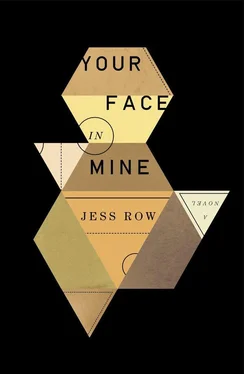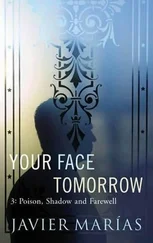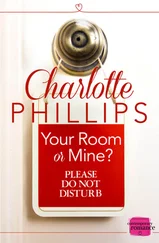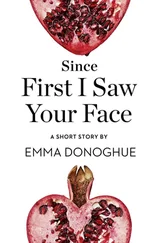And that’s still my type, if I have a type. Not long after my dinner at Martin’s, not more than a few days, I found one of the sites I look at when I need to remind myself to jerk off — which I’ve had to, ever since the accident — and nothing worked. So I crawled into bed, with half a hard-on, read a chapter of a Paul Bowles novel I’d had on my night table for months, and finally smoked the end of a joint I’d kept in the freezer since Christmas, a last-ditch effort at deriving some sense of pleasure from the world. It happened quickly after that: I could describe, in my mind’s eye, every part of Robin, the shape of her kneecap, the frictionless skin at the very base of the thigh, the taste of her as I put my mouth between her legs. I came explosively.
And is it really so surprising? I asked myself a few moments later, after I’d tossed away the tissue and pulled up the sheet, my heart still pulsing away as it did, does, after sex, the real kind. How else is there to say it: Martin has everything I want, everything any one wants, even if he took the strangest, technically impossible, route to get there. Of course I look at his beautiful wife — his poised, put-together, self-assured, hyperconfident Doctor Mom — and want to fuck her, to bend her over, to shove her up against a wall. Lust is circumstantial and unfair. I’m not sorry. We know enough now, adults that we are, evolved people, not to have to apologize for our fantasies. Of course it occurs to me now that I wasn’t ever attracted to black women partly because no one ever would have wanted me to be, because it’s inconvenient, unsightly, because the image it brings to mind, let’s just say it, is the master and the slave, Sally Hemings and President Jefferson. Lust is circumstantial and politically inconvenient. So is love, for that matter. When Wendy I were first together, one friend said to me, in a drunk late-night overseas phone call, I never thought you were the Suzie Wong type. Another said, how long have you had yellow fever?
So since my night with Rina — two weeks ago, and we’ve had dinner twice since, like any old friends stranded without much companionship, the tension broken, thank god — I’ve tried not to worry about Robin. People have crushes, I’ve been thinking, and that’s what it is; why make it sound more profound, more ominous, than that? What’s going to happen, in any case? I’m in love with you, and by the way, your husband’s really a white man, so what’s the difference, anyway? She’s the Pat Robertson of the black family. And a shrink. Let her set the boundaries. Take notes. Make it all on the record. And move on, and maybe try not to see her again.
—
Don’t sit down, Robin says, when I open the door to her office. I’ll just be a second. She’s already changed into Lycra pants, track shoes, and a fleece pullover; now she’s slipping in contact lenses, using a compact mirror and one long, delicate pinkie. Her nails are very short, I’m noticing, with a dark plum-colored polish, almost black. You okay with walking? she asks. I always walk at lunchtime. First, because I sit all day. Second, because there’s no decent food around the hospital. That’s what happens when you tear down a neighborhood. Fancy MRIs, world-class surgery, but you have to walk a mile for a decent sandwich.
As long as you give me a head start.
Don’t worry. I don’t power-walk with company. Just like to get out of my doctor drag and be a civilian again.
Her building isn’t the hospital itself but one of its many satellites — the Hopkins Hospital, since I lived here, having become a city within a city, taking up a twenty-block square above Oldtown and Butchers Hill. The view from her window takes in the entire horseshoe of the harbor, from Canton to Federal Hill, with Patterson Park on one periphery and Camden Yards on the other, and stretching out to the tankers dotting the gray-green Chesapeake three miles away. The accumulated brightness of it all — the window, the sunburst-patterned rug, the enormous Jacob Lawrence prints above her desk, the clutter of toys and blocks and tiny plastic chairs around my feet — is making me a little dizzy.
I always tell people not to sit down, she says, because otherwise they try to be polite and break one of the little people chairs. It’s not a kindergarten class where the parents come in for conferences. In here it’s me and the kids only. I do consulting with the grown-ups next door.
What kinds of cases do you handle?
What kinds of kids? Every kind. I get referrals from all directions. Schools. CFS. Primary-care doctors. Juvenile Justice. The courts. Adoption agencies. Homeless shelters. All the way from mild adjustment issues to full-on psychosis. There aren’t enough child psychs in this world to let me be picky. She directs me to the door, waves to her assistant, and we’re in the elevator on our way down. Like this morning, she says, two appointments. Just to give you a sense of the range. First one, hyperactive mom, lives in one of the new Ritz-Carlton condos over near the Domino’s sign. She works in D.C., has a nanny seven to seven. Single, Dad’s already remarried and lives in Spain. Wants to know whether Jacob — he’s three and a half — needs Ritalin because he keeps breaking his toys. That’s number one. Number two, she’s eleven, six foster families, raped by an older foster brother two years ago, prematurely pubescent, getting in trouble hanging out with boys after school. She’s a candidate for early pregnancy for sure.
It’s pretty much the whole demographic slice.
You know who I don’t see? The suburban middle class. I mean, obviously, given where I work. But my kids break high and low. Because that’s who lives in Baltimore these days. You’ve got profoundly wealthy people in Guilford, old-line Wasp money in Roland Park, yuppies of all kinds around the harbor, and then profoundly, profoundly poor people, black, brown, beige, and white, too, of course, everywhere else. What you don’t have are teachers, nurses, firemen, shopkeepers, managers, what have you. They live in the county. And, of course, they don’t get to see a mental-health professional more than once or twice in their lives, because their HMOs don’t cover us. Medicaid, yes. The prisons, yes. Rich people, yes. Baltimore is like a big donut with the middle shot out.
We’ve come out on the corner of Wolfe and Orleans and now turn down North Broadway, a broad avenue of neat brick row houses that descends slowly to Fell’s Point. You like Broadway Market? she asks. It’s soft-shell season, you know. Or we could go to Bertha’s, but I think it’s overrated. Or the brick-oven pizza place.
No, the Market’s fine.
I like eating standing up. Don’t know why. Some people can’t take it. But again, I’m sitting all day. Standing up and reading the newspaper and listening to adults talk. Between work and home I get a little starved for conversation, as you can see. So listen, what was it you wanted to ask me? You must have questions.
Oh, I say, you’re answering them. Mostly I just need background. Who you are, what you think about the life you lead.
Nothing about how I met Martin? That kind of thing?
Of course. That, too.
And you’re not going to ask for my take on black entrepreneurship?
Definitely.
She bursts into laughter. I’m just giving you a hard time, she says. Listen, I could rattle off opinions for hours, so let me get some hard facts out of the way before I forget. About Martin, first off. We met in church. He probably told you that. And it was the first time I’d been to church in about three years; I was there for my friend Kara’s daughter’s baptism. He, at that time, was quite the faithful churchgoer, and my god, a single man, looking like him, with a job, with a wardrobe , and without a mother in law — there were crowds. It was like the Google IPO. But our eyes met, la, la, la, we clicked, it all happened fast. It was very efficient. Small wedding, up on Martha’s Vineyard. You have to keep it small when there’s no family on one side.
Читать дальше












